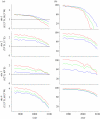Impact of aragonite saturation state changes on migratory pteropods
- PMID: 21849324
- PMCID: PMC3248718
- DOI: 10.1098/rspb.2011.0910
Impact of aragonite saturation state changes on migratory pteropods
Abstract
Thecosome pteropods play a key role in the food web of various marine ecosystems and they calcify, secreting the unstable CaCO(3) mineral aragonite to form their shell material. Here, we have estimated the effect of ocean acidification on pteropod calcification by exploiting empirical relationships between their gross calcification rates (CaCO(3) precipitation) and aragonite saturation state Ω(a), combined with model projections of future Ω(a). These were corrected for modern model-data bias and taken over the depth range where pteropods are observed to migrate vertically. Results indicate large reductions in gross calcification at temperate and high latitudes. Over much of the Arctic, the pteropod Limacina helicina will become unable to precipitate CaCO(3) by the end of the century under the IPCC SRES A2 scenario. These results emphasize concerns over the future of shelled pteropods, particularly L. helicina in high latitudes. Shell-less L. helicina are not known to have ever existed nor would we expect them to survive. Declines of pteropod populations could drive dramatic ecological changes in the various pelagic ecosystems in which they play a critical role.
Figures



Similar articles
-
Dissolution dominating calcification process in polar pteropods close to the point of aragonite undersaturation.PLoS One. 2014 Oct 6;9(10):e109183. doi: 10.1371/journal.pone.0109183. eCollection 2014. PLoS One. 2014. PMID: 25285916 Free PMC article.
-
Response of the Arctic pteropod Limacina helicina to projected future environmental conditions.PLoS One. 2010 Jun 29;5(6):e11362. doi: 10.1371/journal.pone.0011362. PLoS One. 2010. PMID: 20613868 Free PMC article.
-
Poles apart: the "bipolar" pteropod species Limacina helicina is genetically distinct between the Arctic and Antarctic oceans.PLoS One. 2010 Mar 23;5(3):e9835. doi: 10.1371/journal.pone.0009835. PLoS One. 2010. PMID: 20360985 Free PMC article.
-
Evolution and biomineralization of pteropod shells.J Struct Biol. 2021 Dec;213(4):107779. doi: 10.1016/j.jsb.2021.107779. Epub 2021 Aug 30. J Struct Biol. 2021. PMID: 34474158 Review.
-
Ocean acidification and coral reefs: effects on breakdown, dissolution, and net ecosystem calcification.Ann Rev Mar Sci. 2013;5:321-48. doi: 10.1146/annurev-marine-121211-172241. Epub 2012 Jul 9. Ann Rev Mar Sci. 2013. PMID: 22881351 Review.
Cited by
-
Time-calibrated molecular phylogeny of pteropods.PLoS One. 2017 Jun 12;12(6):e0177325. doi: 10.1371/journal.pone.0177325. eCollection 2017. PLoS One. 2017. PMID: 28604805 Free PMC article.
-
Dissolution dominating calcification process in polar pteropods close to the point of aragonite undersaturation.PLoS One. 2014 Oct 6;9(10):e109183. doi: 10.1371/journal.pone.0109183. eCollection 2014. PLoS One. 2014. PMID: 25285916 Free PMC article.
-
Antarctic environmental change and biological responses.Sci Adv. 2019 Nov 27;5(11):eaaz0888. doi: 10.1126/sciadv.aaz0888. eCollection 2019 Nov. Sci Adv. 2019. PMID: 31807713 Free PMC article. Review.
-
Adverse effects of ocean acidification on early development of squid (Doryteuthis pealeii).PLoS One. 2013 May 31;8(5):e63714. doi: 10.1371/journal.pone.0063714. Print 2013. PLoS One. 2013. PMID: 23741298 Free PMC article.
-
Global biogeography and evolution of Cuvierina pteropods.BMC Evol Biol. 2015 Mar 12;15:39. doi: 10.1186/s12862-015-0310-8. BMC Evol Biol. 2015. PMID: 25880735 Free PMC article.
References
-
- Sabine C. L., et al. 2004. The oceanic sink for anthropogenic CO2. Science 305, 367–37110.1126/science.1097403 (doi:10.1126/science.1097403) - DOI - DOI - PubMed
-
- Meehl G. A., Stocker T. F. 2007. Global climate projections. In Climate Change 2007: the physical science basis. Contribution of Working Group I to the Fourth Assessment Report of the Intergovernmental Panel on Climate Change (eds Solomon S., et al.), pp. 747–845 Cambridge, UK: Cambridge University Press
-
- Khatiwala S., Primeau F., Hall T. 2009. Reconstruction of the history of anthropogenic CO2 concentrations in the ocean. Nature 462, 346–34910.1038/nature08526 (doi:10.1038/nature08526) - DOI - DOI - PubMed
-
- Caldeira K., Wickett M. E. 2003. Oceanography: anthropogenic carbon and ocean pH. Nature 425, 365.10.1038/425365a (doi:10.1038/425365a) - DOI - DOI - PubMed
-
- Leggett J., Pepper W. J., Swart R. J. 1992. Emissions Scenarios for the IPCC: an update. In Climate Change 1992: The Supplementary Report to the IPCC Scientific Assessment (eds Houghton J. T., Callander B. A., Varney S. K.), pp. 69–95 Cambridge, UK: Cambridge University Press
Publication types
MeSH terms
Substances
LinkOut - more resources
Full Text Sources

